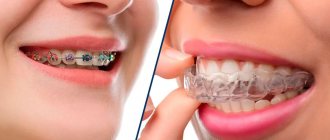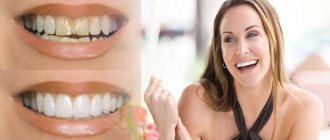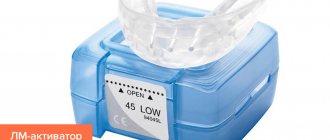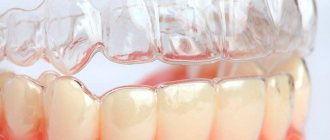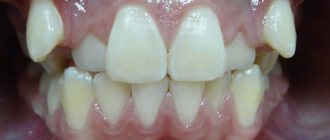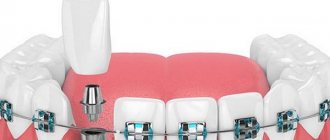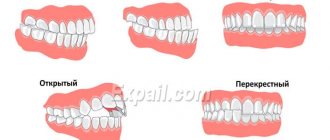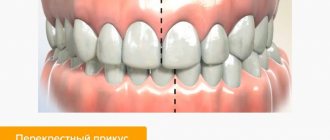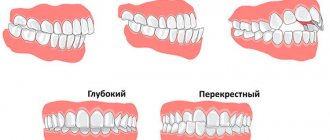Can! Braces are not the only corrective method: orthodontists have several alternative methods for straightening teeth. The easiest way to do this is if the pathology is not clearly expressed, but even in difficult cases it is possible to do without a bulky structure in the mouth.
Mild bite pathologies: plates, trainers, veneers
The easiest way to correct a bite without braces in adults is if there is minor bite pathology. In this case, there are several options.
- Trainers.
Removable silicone or plastic design that does not require custom fitting. Trainers normalize the functions of the facial muscles and align the jaws relative to each other - in some cases this is enough to bring the bite back to normal. They are worn at night and are not required to be worn during the day. - Veneers and lumineers.
A cosmetic (and therefore the fastest) way to straighten your teeth. With the help of ceramic onlays you can get rid of minor defects, for example, to close a small diastema or a crooked tooth.
Signs of correct bite
Normally, the jaws make close contact when closing. In this case, the upper teeth cover the lower ones by about a third, so that the palatal tubercles of the former touch the incisors of the latter. There are no gaps between them both when the mouth is closed and during chewing. The facial proportions are symmetrical.
Also among the characteristic features:
- absence of speech defects;
- no clicking or other similar discomfort in the joint;
- ease of biting food.
And vice versa, if problems are observed in any of the points just listed, this is an alarm bell and a reason to consult an orthodontist, and immediately, without waiting for the situation to worsen.
What are aligners and how do they work?
Aligners are a completely transparent “cover” that fits over your teeth. Its shape almost completely follows the shape of the dentition, but is slightly different in order to create the pressure necessary to move the teeth. Aligners must be worn constantly, like braces, but, unlike the latter, they are almost invisible, feel much more comfortable in the mouth and can be removed by the patient independently if necessary. Every 2-3 weeks, the mouthguard needs to be replaced with a new one so that the pressure on the teeth does not weaken. Thus, a course of bite correction without braces in adults will require 20 drops.
The main feature of aligners is the absolute predictability of treatment. Before it begins, the doctor, based on the diagnostic results, creates a computer prototype of the patient’s jaw, models the trajectory of teeth movement on it and can demonstrate the final result. This approach makes it possible to clearly plan the entire process, accurately calculate how long it will take, understand how many trays will be needed and what the cost of correcting a bite in adults without braces will be.
The mouthguards are made individually for each patient using 3D printing. Each subsequent set moves the teeth a little stronger than the previous one to the ideal position. The patient can change the aligners himself after a two-week period, so it is necessary to come for a follow-up examination no more than once a month.
Hygiene when wearing aligners is simpler than when correcting a bite with braces: you don’t have to acquire a large number of devices, and it takes much less time to clean. The mouth guards are easy to clean with a simple toothbrush, and dental care is no different from usual.
Corrective exercises – myotherapy
As a rule, myotherapy is an addition to the correction of occlusion using various orthodontic devices or as the main method in the treatment of children from 4 to 8 years old. Physical exercises help develop and strengthen facial muscles, stimulate bone growth, and have a positive effect on trophic processes.
Let's look at some effective exercises:
- to correct a deep bite: stand straight with your chin raised as much as possible. Move the lower jaw forward, then return to its original position. Repeat 15 – 17 times;
- to correct open occlusion: take a pencil (you can put a rubber tube on it), squeeze it with your teeth with adequate force. Perform for 4 – 5 minutes;
- with a crossbite: open your mouth as wide as possible, move your jaw towards the defect, close your jaws in the correct position for 5 seconds, then relax, then repeat the exercise again;
- to correct mesial occlusion: use your tongue to press on the inside of the front part of the upper dentition. Perform the exercise for 5 minutes.
Important: when performing any exercises of the myogymnastics complex there should be no pain. After each approach, you need to let the muscles relax for 1 minute.
What types of aligners are there?
A technique for correcting malocclusion in adults without braces was invented in the late nineties in America. Since then, the technology has been replicated by other manufacturers, including Russian ones. There are now several brands of mouth guards for bite correction on the market.
- Invisalign
is a product of Align Technology, the most popular, effective and expensive aligners. In addition to the high price, they have another disadvantage: after diagnosis and drawing up a treatment plan, you have to wait a long time for the delivery of a set of mouth guards from the USA. - OrthoSnap
is another American manufacturer of aligners. It costs less, but has the same logistical problems as Invisalign. - Star Smile
is a Russian analogue of American orthodontic systems. Production is located in Russia, so the price of these aligners is lower and delivery is much faster. - 3D Smile
is another popular Russian manufacturer of aligners.
Classic vestibular braces
They are also external braces - the most common. These braces are fixed on the outer surface of the teeth, the one we see when we smile.
Vestibular braces are the most popular system for correcting malocclusion, but they are not the only one, including for adults.
Ligature braces (the arch is secured with special rubber bands - ligatures)
Advantages of external braces in the treatment of malocclusion:
- This is the most functional device that we can use in adults. Corrects all possible malocclusions. If the case is complex and surgery is needed, braces are worn before or after it. In addition, they can be supplemented: install springs, rods, buttons, ligatures, chains for pulling out impacted teeth. The more complex the pathology, the greater the likelihood that something additional will need to be tightened, and this is where such a wide functionality of braces comes in handy.
Example: a spring connects the braces and forms the bite
- The second plus is a consequence of the first: braces provide the maximum effect of expanding the dentition. If the row is significantly narrowed compared to the norm, braces are most preferable. In addition, the narrowing of the dentition is most often accompanied by the absence of some teeth (that is, they are there, but are located inside the gums - they remain impacted). And pulling out impacted teeth using an arch of braces is justified and convenient.
- Price. You can choose to suit any budget. Expensive - transparent sapphire and for a relatively small amount - metal. Visually they are less attractive, but no worse in efficiency.
Aesthetic ceramic braces are less noticeable.
External braces also have disadvantages. Moreover, they are the same for any system, both the simplest metal one and the aesthetic one with white or transparent braces.
- Any external braces, even white-painted arches, are still noticeable. And this often influences the choice: not all adults are ready to wear them. Although no one is surprised by braces for a long time, and no one pays attention to them, for many it is still a psychological barrier.
- It is more difficult to maintain hygiene. Although adult patients usually take a conscious approach to treatment and follow all recommendations, force majeure nevertheless occurs: trips on vacation or a business trip, where there is no time or it is inconvenient to constantly brush your teeth after eating. Braces are a non-removable structure, you have to eat with them, and leftover food remains on them. You have to spend about 20 minutes on each brushing (about an hour a day in total), otherwise plaque will form, which increases the risk of developing caries. Braces themselves do not cause caries and do not spoil the enamel - plaque damage due to poor hygiene does.
- Wearing braces hurts. Although this is subjective, it all depends on the individual and pain threshold. In the first days after activation of the system (it is carried out every month), some patients sometimes have to take pain medication. In addition, the protruding parts of the braces can scratch the oral mucosa and rub it. For most patients, this goes away within a few days, while others experience discomfort from such side effects throughout the entire treatment period. But you can seal the protruding areas of the braces with orthodontic wax.
This is what braces with protective wax look like
- You are not allowed to eat all foods with braces, even after the pain subsides. Avoid solid foods - hard fruits and vegetables, nuts. Chewing meat also becomes difficult, as fibers become clogged in the space between the teeth and the arch. The fact that you will have to eat food pureed through a blender for a year is an exaggeration, but you can forget about some delicacies for a year and a half.
Braces are effective for treating adults, but you have to come to terms with the shortcomings of this technology. Spend a lot of time taking care of your teeth, limit yourself to certain dishes, get used to your smile with “decoration”.
How is a bite corrected using aligners?
Correcting a bite with aligners takes place in five stages and involves a fairly long – about a month – preparatory period.
First stage
includes an initial consultation, a thorough examination, diagnosis and, if necessary, dental treatment. Caries, pulpitis, inflammatory processes and other problems in the oral cavity are a direct contraindication to the use of aligners.
Second phase
— collection of materials for the dental laboratory: taking impressions, orthopantomogram, computed tomography.
Third stage
- laboratory. A three-dimensional model of the patient’s jaw is created on a computer, the process of teeth movement is simulated, the duration of treatment is calculated, and the required number of drops is determined. The tray set is printed on a high-precision 3D printer.
Fourth stage
- immediate start of treatment. The doctor shows the patient how to put on and remove the aligners, explains how to care for them, and applies a few drops of a special composition to the tooth enamel that improves adhesion.
Fifth stage
- the longest, includes the entire period of wearing the aligners. It can last from several months to one and a half to two years - until the desired result is achieved.
Indications
- open lateral bite. It is characterized by the presence of a gap between the jaws: the face becomes asymmetrical, the functioning of the facial muscles is disrupted, and the risk of damage to the mandibular joint increases. The patient is unable to chew food or swallow/breathe normally;
- incorrect frontal closure. Provokes disruption of the chewing process, distorts diction;
- chin dysplasia. With this pathology, the configuration and shape of the chin are greatly changed, as a result of which the appearance deteriorates and problems arise with closing the lips and diction.
Contraindications
: age under 18 years, diabetes 2-3 degrees, diseases of the blood, heart muscle, blood vessels, individual intolerance to anesthesia, oncology.
Bite correction without braces in adults: are prices affordable?
Aligners are a high-tech product that provides patient comfort and predictable results, so their price is higher than classic braces. In Moscow, prices for bite correction without braces for adults start at 150,000 rubles. The most expensive are American Invisalign aligners: their cost can reach up to 350,000 rubles, Russian developments will be cheaper. The final cost of treatment depends on the duration of wearing the trays and their number. Your doctor will be able to tell you the exact price for correcting a bite in adults without braces after a consultation. Many clinics offer payment for treatment in installments, breaking the entire amount into several payments.
Contraindications to surgery
Correction of the bite in a dental clinic by surgical intervention is not performed in children and adolescents, as well as in older people. The operation involves risks, so there are restrictions on its implementation.
Surgical bite correction is contraindicated in patients who have:
- pathologies of the cardiovascular system;
- blood diseases, including poor clotting;
- diseases of the skeletal system;
- dysfunction of the endocrine system;
- severe form of diabetes mellitus;
- mental illness;
- immunodeficiency diseases;
- acute inflammatory, infectious or viral diseases.
Surgical treatment of malocclusions is not performed for aesthetic purposes. The main task of the maxillofacial surgeon is to restore all functions for which the dentofacial apparatus is responsible, as well as eliminate concomitant pathologies.
What to do in the postoperative period
In addition to following all the instructions of the attending physician, you need to pay attention to several important points.
- You need to apply ice to the jaw area and apply ointment or gel for swelling.
- Strictly observe daily routine and hygiene: get up, walk around, do not smoke, eat.
- Avoid heavy objects, do not bend over, avoid sudden movements.
- Do not hesitate to seek help if there is any discomfort.
The second most popular question concerns nutrition during the postoperative period. Contrary to expectations, the straw does not always help. According to reviews from people who have undergone this operation, it is better to use a small spoon. The only difficulty with eating usually is that it takes longer. In the hospital, during the postoperative period, patients are prescribed a gentle diet, in which dishes are served pureed.
Immediately after returning home, you can choose your usual menu, guided by your preferences. However, at first, the food should still be pureed. If necessary, you can consult a gastroenterologist.
Factors contributing to the occurrence of pathology
There can be an incredible number of reasons why such a defect as malocclusion can occur, but there is the most basic one - heredity. In other words, if at least one of the relatives has such a defect, the probability of its manifestation in the child is 50%
An incorrect bite can occur when the facial bones are injured and even when teeth are knocked out. In this case it is noted:
- tooth displacement;
- increasing the space between teeth;
- the appearance of a change in the nature of the closure of the upper and lower dentition.
There is one more reason that cannot be ignored, and this is the partial or complete absence of breastfeeding in newborn age. For this reason, pathologies can occur extremely rarely, but this is quite possible. Experts believe that the process of sucking breast milk allows you to complete the development of the jaw and thereby eliminate not only the defect in the form of malocclusion, but also such consequences as burr and unclear diction.
Treatment with transparent aligners
The undoubted advantage of aligners is that you can evaluate the effectiveness of treatment even before it begins. A special computer program calculates the exact timing of using the trays and allows you to visualize the results of treatment. A set of mouth guards is manufactured immediately for the entire period of orthodontic treatment. The patient independently replaces the mouthguard with a new one every two weeks. The mouthguards can be removed when eating, brushing teeth, and in vital situations. They must be worn at least 22 hours a day. The system does not in any way complicate the process of brushing teeth and does not affect the quality of oral hygiene. The risk of developing caries during orthodontic treatment with clear aligners is minimal. Also, you do not have to buy special brushes and special devices for cleaning your teeth.
When can a malocclusion be corrected?
Malocclusion can be corrected at any age. This has been confirmed by numerous studies and the experience of our patients.
For each age, it is recommended to use certain braces. They regulate both the time of the procedure and its effectiveness. For example, for children under 16 years of age, you can choose any braces - from metal to lingual. At a more mature age, it is worth paying attention to self-regulating braces - their functional features allow you to obtain optimal results in a relatively short time.
Important: Bite restoration is not the most terrible procedure. Therefore, you should not wait until health problems or complexes take over - just contact one of our clinics and be beautiful.
Preparing for surgery
After a comprehensive examination of the whole body for the presence of contraindications, the oral cavity, and the structure of the skull bones, the doctor begins the preparatory period for the operation:
- Using casts of the jaw, a model is made using high-tech equipment, which will be a sketch of the postoperative jaw apparatus.
- The orthodontist prepares the teeth for surgery by installing braces to pre-align them. This stage is the longest and takes from six months to 1.5 years (possibly longer in the presence of a serious anomaly). While wearing braces, it is important to follow the recommendations of doctors and visit regularly to adjust the braces and evaluate the current result of treatment.
The clinic has the latest equipment, which allows us to conduct any examination of teeth and jaw bones, thanks to which the diagnostic accuracy is at the highest level. And, as you know, a correct diagnosis is half the success of treatment.
Can complications occur after orthognathic surgery?
The result of this surgical intervention is completely predictable, so complications after surgery in most cases should not occur. There may be temporary numbness of the lips. However, in the postoperative period this is acceptable and even helps the patient avoid pain. When the previous sensitivity of the lips returns, there is no more pain.
You can insure yourself against the negative consequences of surgery if you seek help from reliable specialists.
